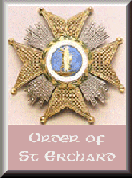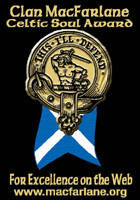


Welcome to the world's first web site dedicated to the Picts! On the web since 1994! In here I want to make some things available to potential Pictophiles and all others who come to visit. First of all, I want to create the world's first page dedicated to that ancient race (known as the Picts) whom once inhabited present day Scotland. I will try to link all Pictish pages on the web here. If you know of one I've missed, please email me with its URL and I will add it. Furthermore, for really serious Pictophiles, I recommend joining the Pictish Arts Society, which is truly the world's finest organization dedicated to preserving and expanding interest in Pictish culture. As such I enthusiastically recommend you join them! To read some books about the Picts visit the link at the bottom of the page. Finally, those of you who saw the TBS Special on June 28, 1998 "Tattoos: Women of the Ink", Let's get those letters flowing to the National Geographic and maybe they'll take a look at them too! If you liked the TBS piece, write to them and tell them you'd like them to do a program on the Picts! Their address is: Turner Original Productions, One CNN Center, Box 105366, Atlanta, GA 30348.
I will also try to create links to artists who work in a Pictish genre and also WHERE you can find them. Since I believe that we about to see an explosion of interest in the art and history of these ancient people, I look forward to the page and its links changing all the time. Visit often!
By now you must be asking.... Who are the Picts???
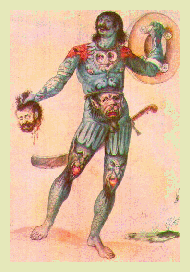
The above words of the Roman poet Claudian perhaps give the only physical description of the race of people known as Picts who once raided Roman Britain, defeated the Angle-Saxon invaders and in one of the great mysteries of the ancient world, disappeared as a separate people by the end of the tenth century. "This legion, which curbs the savage Scot and studies the designs marked with iron on the face of the dying Pict," are the Claudian words which give some insight as to the name given by Rome to the untamed tribes north of Hadrian's Wall . The Romans called this pre-Celtic people Pictii, or "Painted," although Claudius' words are proof that (as claimed by many historians), the ancient Picts actually tattooed their bodies with designs. To the non-Roman Celtic world of Scots and Irish and the many tribes of Belgic England and Wales they were known as "Cruithni" and for many centuries they represented the unbridled fury of a people who refused to be brought under the yoke of Rome or any foreign invader.
The origins of the Picts are clouded with many fables, legends and fabrications, and there are as many theories as to who the Picts were (Celtic, Basque, Scythians, etc.), where they came from, what they ate or drank, and what language they spoke, as there once were Pictish raiders defying the mighty legions of Rome. Legend tells us, perhaps incorrectly, that Rome's mighty Ninth Legion, the famous "Hispana" legion, which had earned its battle honors in Iberia, conquering Celtic Spain for Caesar is never heard of again when faced against the Picts (they actually surfaced years later in Israel). We do know that the Picts may have spoken a non-Celtic language, (although many Celtophiles feel the Picts spoke a Brythonic-Gaulish form of Celtic language) as St. Columba's biographer clearly stated that the Irish saint needed a translator to preach to the Pictish King Brude, son of Maelchon, at Brude's court near the shores of Loch Ness. At other times the Pictish king lived at Scone, and we know there often were two separate Pictish kingdoms of Northern and Southern Picts. We know that they were mighty sailors, for the Romans feared the Pictish Navy almost as much as the wild men who came down from the Highlands to attack the villages along the wall. We also know that as far as the 9th century they wrote in stone a language which was not far in design from the Celtic "Ogham" script but was not Celtic in context, although Prof. Richard Cox thinks that it is Norse, which has really turned the carefully galvanized world of Pictish academic opinions upside down. By the legacy of their standing stones, we know that they were great artists as well. It is also well known that the Picts were one of Western culture's rare matrilinear societies; that is, bloodlines passed through the mother, and Pictish kings were not succeeded by their sons, but by their brothers or nephews or cousins as traced by the female line in (according to the scholar Dr. Anthony Jackson) a complicated series of intermarriages by seven royal houses.
It was this rare form of succession which in the year 845 A.D. gave the crown of Alba and the title Rex Pictorum to a Celtic Scot, son of a Pictish princess by the name of Kenneth, Son of Alpin. This Kenneth MacAlpin, whose father's kingship over the Scots had been earlier taken over by the Pictish king Oengus, who ruled as both king of Picts and Scots, and who possibly harbored a deep ethnic hatred for the Picts, and in the event known as "MacAlpin's Treason" murdered the members of the remaining seven royal houses thus preserving the Scottish line for kingship of Alba and the eventual erasure from history of the Pictish race, culture and history.
The true mystery in Pictish studies is the extraordinary disappearance of the culture of the tattoed nations of the North. The fact that within three generations of MacAlpin kings, the Picts were almost held in legendary status as a people of the past must be the real question to be answered, and the historian is consumed by legend, lack of facts and the nagging story of an obscure intrigue leading to genocide of a people, its customs, culture, laws and art.
It is in the sculptured stones of Scotland, left behind by the Pictish and proto-Pictish people of ancient Alba and present day Scotland that we can find some information about a mighty race of people who defied and defeated Rome and who slaughtered the invincible barbarian hordes of Angles Germans at Nechtansmere in Angus, and hammered the invading Vikings back home thus forever preserving a separate culture and race in Scotland. It is in these sometimes mighty, sometimes delicate stones that the history of ancient Scotland is now recorded. Were they descendants of the ancient Basque people of northern Spain once known to Rome as Pictones, who then migrated to northern Britain after they had helped the Empire defeat the seagoing people of Biscay? Or are they descendants of the dark tribes of ancient Stygia and the huge Eastern steepes? No one knows - only the Stones.
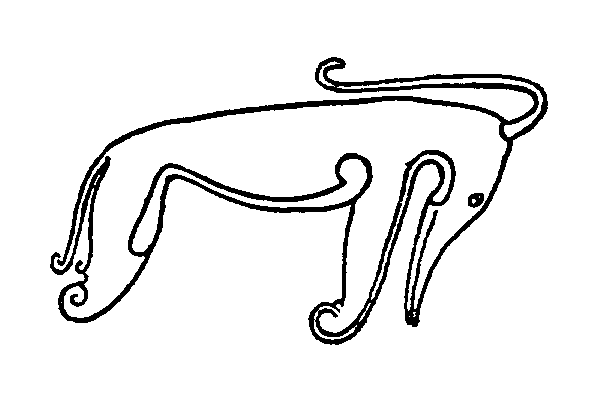
Perhaps the greatest mystery of Scottish or even European history is the people who once inhabited the lands north of Hadrian's Wall and as far north as the Shetlands. Who were these fiercely independent people? Where did the come from? Which language did they speak? What did they call themselves? We first hear of them in the third century from a Roman writer, who describes their fierceness and battle skills. The writer Eumenius, writes about them 200 years after Rome has been in Britain, and the name associated with the Pict is forever coined. To this day, we do not know if this is truly as in "pictus" (the Latin for "painted") or a Latin form of a native name. Because of the isolation of northern Scotland, history yields little, and the Roman Empire's expeditions into the north ended in little gains.
The above words by the Pictish chief Calgacus are recorded by the Roman enemy in the words of Tacitus and are a perfect example of the obscurity and legendary status held by the Picts almost 2,000 years ago.
The earliest recorded evidence of man in Scotland is dated to 8,500 B.C. It is thus that a few thousand years before the birth of Christ, Neolithic men from Spain and France, makers of fire and herders of sheep and cattle had already made their way to Scotland. Some archeologists suggest that these people may have built and used the great chambered cairns which dot the Scottish countryside. It has also been suggested that their descendants eventually merged with the Beaker people (who probably came from northern Europe), and this ethnic union made up the pre-Celtic stock of the northern lands.
The link of these early inhabitants to their Iberian ancestors can be found in the many spiral pattern grooves cut into the rocks and boulders of this northern land and which can also be found in Spain, France and Ireland. The design of burial chambers located in the Orkney islands also provide an important link to the Iberian origin of their builders. Farming arrived in these islands around 4,000 BC (3-4,000 years after it started in Asia Minor) and as it replaced the nomadic way of life, the Orkneys became an island fortress with its many stone settlements. By the time Rome became a world empire, the Orcadians were recognized by Rome as a sea power. From recent excavations, it seems that these Orcadian people were a slim, swarthy Caucasian race, with long, narrow heads.
The great stone circles such as Sunhoney were probably being built around 3,300 BC, quite possibly around the same time as the arrival of the Beaker people from Northern and Central Europe. These newcomers were of a different ethnic group from the Iberian stock in northern Britain, as their skulls were much broader and round. Evidence of contact between these new people and their continental ancestors have been discovered in several excavations, and seem to indicate a flourishing trade between ancient Scotland and Europe. It is thought by many scholars that the union of these two peoples resulted in the creation of the pre- Celtic stock eventually loosely called Pict by the Roman and Cruithne by the Celts.
The arrival of the Celts to Britain and Ireland brings yet another culture to these northern parts. The Irish call themselves the "Milesian race," based on the myth that they are descended from Milesius, a Celtic King of Spain.
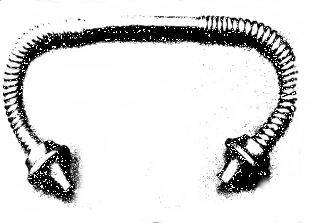
The Celts arrived in Britain around 500 B.C. A nomadic people whose culture spread from Eastern Europe to Iberia, they were sometimes described as as fair headed, tall, fierce warriors by the Greeks (Since many Celts dyed their hair with lye, some historians believe that this is what the Greeks meant by fair-headed) althought the Britannic Celts encountered by the Romans were usually described as dark haired and short. As a warrior culture, it was a Celtic army which nearly destroyed Rome in her early days and thus forever made themselves an unforgivable enemy of the Latin empire. Because the first historical reference to the Picts appears in 297 A.D., when they are mentioned as enemies of Rome in the same context as the Hiberni (Irish), Scotii (Scots) and Saxones (Saxons), many historians assume that the Picts were simply another Celtic tribe. Although is quite probable that there was much Celtic stock in some of the southern tribes in the loose federation of tribes which eventually made up the Pictish nation, it is my opinion that the vast majority of the Pictish peoples north of the Forth were made up mostly from the earlier, pre-Celtic people of northern Britain. Some historians use Ireland as an example, and Michael Lynch eloquently states that "Whatever the Picts were, they are likely, as were other peoples either in post-Roman western Europe or in contemporary Ireland, to have been an amalgalm of tribes, headed by a warrior aristocracy which was by nature mobile. Their culture was the culture of the warrior... ." More on this later.
The bottom line is that so little is known, that most Pictophiles need to make huge leaps and prodigious interpretations of the "facts" to state their views. The explanations migrate to this core of "facts" in a futile effort to explain this mysterious people.The Romans came to Scotland, often defeated the Picts in battle, but they never conquered them or the land on which they lived. By the third century A.D. the Roman general Agricola slaughtered a Pictish army led by the quoted Calgacus, the Swordsman (as many of 10,000 Picts may have been killed and 340 Romans). The Picts who fought Agricola at Mons Grampius were described as tall and fair headed. Agricola's legions halted near Aberargie in Perthshire, where they built a fort. They also met a new tribe of barbarians, who the Romans described as swarthy and looking like the Iberians they had conquered in southern Spain. It was to retain control of the advances made by Agricola that several forts were built between Callander near Stirling up to Perth. Within thirty years of their establishment, the Picts had destroyed and burned the Roman forts, and according to Victorian legend, Rome's most famous legion, the Ninth was sent north from Inchtuthil to perhaps relieve Pictish pressure. Legend has it that legion was massacred and forever lost in some unknown battle against the painted men of the north, although history shows us that the Ninth reappears later on in Judea.
It was Hadrian who decided that northern Scotland was not worth more legions, and so he pulled back the Empire to the Tyne and the Solway. There he built the famous wall which bears his name, seventy miles from sea to sea. Perhaps because of constant warfare and attacks against the wall, that Antoninus Pius advanced the frontier again to the thin Scottish neck between the Forth and Clyde. Thirty nine miles long and boasting twenty forts, it may have separated Pictish tribes on either sides of the wall. The wall was manned by the Second, Sixth and Twentieth Legions during its forty years. The Picts never ceased attacking it, and in fact the Romans lost it and regained it twice before finally giving it up by the end of the second century and retreating to Hadrian's Wall. We lean from the words of Cassius Dio that the northern tribes "crossed the wall, did a great deal of damage and killed a general and his troops."

In 208 A.D., the governor of Britain was forced to appeal to the Emperor for help against the barbarians, and Septimus Severus decided to come to Britain together with his sons. The old soldier took a Roman fleet loaded with 40,000 centurions into the Firth of Forth, landed a vengeful Roman army ashore, and although he defeated every Pictish army he met and beheaded every Pictish chief who failed to surrender, he failed to conquer the land which he called Caledonia and he too was soon dead. However, the lesson grimly taught by the Roman and the decimation caused in the Pictish countryside must have been of such consequences that for nearly a century peace was kept in the land; the Romans manned Hadrian's Wall and the northern tattoed tribes stayed in their grim, brooding hills north of it.
The fourth century erupts in warfare again and in 305 A.D. the Romans fought against "Caledones and other Picts." The northern tribes are now called "Picts" by their enemies, and in the south, Scots, Saxons and Franks also add to the woes of Rome by raiding southern Britain. In 343 A.D. Constans starts a campaign against the Picts and probably entered into a truce with them. In 360 Ammanius Marcellus states that the "Picts were now two peoples - the Dicalydones and Verturiones." That same year, the truce is broken and the Picts, allied with the Scots of Ireland pour through the wall into northern England and are repulsed back. They kept hammering at the wall, and may have in fact joined in a multi- tribal alliance against Rome. In 382-3, allied with the Scots they again invade England, and this time the damage done to the wall and its forts is never repaired although the invaders are driven back by Magnus Maximus. The end of the century brings yet another Pictish invasion, this time met by the great Roman general Stilicho himself, who also manages to send the great Irish hero Niall of the Nine Hostages, scampering back to Ireland.
By 409 the Roman hold on Britain was slipping away, and Britons were told to defend themselves. About this time the Celtic Gaelic tribe of Scots begins settling in the southwest of Scotland, creating the kingdom of Dalriada in Argyll (Oir Ghaedhil or Eastern Gaels). Out of the need to protect themselves from the barbaric Pictish and Scottish hordes, a new kingdom is created by the Britons of Strathclyde, who spoke a Celtic tongue much like their cousins in Wales. By 450 the Picts are pouring into the south again, and the monk Gildas calls them the "foul hordes of Scots and Picts, like dark throngs of worms who wriggle out of narrow fissures in the rock when the sun is high and the weather grows warm." This is the last time we hear of the Picts and Scots fighting as allies, and if we take Gildas literally, the Scots return to Ireland around this time. In 461, St. Patrick dies, but Christianity is well spread in Ireland.
By studying the Roman accounts of the Pictish Wars as well as later accounts, it appears that the Pictish lands were essentially north of the Forth-Clyde line, north of the Antonine Wall. Roman pacification, and Celtic and Saxon migration from the south would have erased any Pictish claims to people or lands south of the wall. In the west, Pictish presence in Argyll must have disappeared quickly after the arrival of the Scots of Dalriada around 500 A.D., although as evidenced by the standing stone near the entrance to Inveraray castle in Campbell country, they were there at one point in their history. In the north, Pictish influences reached as far north as the islands went and stones have been found in nearly all of them. This land was defended many times after the departure of Rome's legions. The Picts fought invasions by the Scots in the west, the Britons and Angles in the south and the Vikings in the north. They sometimes lost great battles and huge chunks of land, only to regain it in the vicious warfare of the Dark Ages. In the 7th century the Scots pushed their frontier far north, and a victorious Celtic army came within a half-day march of the Pictish capital of Inverness in the north before it was crushed. In the south, the Angles marched their Teutonic armies north and held Pictish lands for thirty years before they were butchered and sent fleeing south by a united Pictish army.
Although historians disagree on nearly everything which has been written about the Picts, and they disagree on the following, it is thought that the Picts had 69 Kings. Click below to discover...
Try your search in the British Amazon as well...
